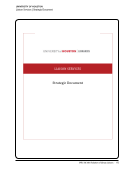SPEC Kit 349: Evolution of Library Liaisons · 95
Challenge to balance the workload across liaisons (one big department versus many small departments—what is fair?).
Challenge to liaisons in meeting the needs and demands among different disciplines. Challenge to communicate with
other library departments about academic departmental needs.
Changing old habits (both staff and faculty) about library services. Difficult to provide pro-active service to all
departments with existing staff. Greater importance of domain knowledge for liaisons many support departments they
do not have deep knowledge in.
Communication. Awareness by users. Consistency of service by all campus libraries.
Competing demands: Users expect quick response times for customer service vs. librarians’ time needed for ongoing
project management. Scale-up: Effective outreach can lead to challenging demands. Effectiveness and outcomes
measures vary across disciplines. Identifying success measures is a challenge.
Convincing faculty and departments of liaison value. Coming up with the finances to purchase items liaisons request.
Being able to hire and retain enough faculty to support a functional liaison program.
Departmental liaison only helps us understand individual faculty needs, and those often vary from the priorities of
departments, divisions, and the VP/provostial level. Liaisons have varying skill levels, making it difficult for them to
establish disciplinary credibility. Supervisors are frequently disengaged from liaison as a priority.
Despite our best efforts, not all campus programs, faculty, and students, take full advantage of liaison services. Data/
statistics keeping is time consuming and cumbersome.
Difficult to fulfill liaison duties in addition to other responsibilities. Some departments/schools could actually use more
than one liaison.
Disinterested faculty, department heads, or deans. Varying size of departments can create workload issues. Too many
departments for the number of liaisons.
Do not have enough people/librarians. Do not have enough time to accomplish all that could be done to support faculty
and students. Do not have enough money to provide everything that faculty and students need.
Faculty &students are very busy. Financial constraints in the Libraries. Time constraints in the Libraries.
Faculty apathy. Closed communication of some departments (librarians not allowed to attend department meetings or
post to email lists). Scale of audience.
Getting everyone up to speed on new services and documenting impact. Letting go of previous duties. Providing
adequate support.
Getting the attention of faculty on library matters. Reaching the entire campus community. Keeping librarian skills
relevant and current.
Having enough staff to match up with the large number of academic and administrative departments is challenging.
Inconsistent utilization of liaison services. Over-demand for specific specialized services. Cross-training.
Increasing workloads and needs for efficiently delivering services. Need to keep up with constantly changing landscape
of scholarly communication. Interdisciplinary scholarship may require expertise in multiple subject areas.
Insufficient funds to provide all resources requested. More individuals are needed to support our current community, as
well as new programs and faculty that are being introduced.
Challenge to balance the workload across liaisons (one big department versus many small departments—what is fair?).
Challenge to liaisons in meeting the needs and demands among different disciplines. Challenge to communicate with
other library departments about academic departmental needs.
Changing old habits (both staff and faculty) about library services. Difficult to provide pro-active service to all
departments with existing staff. Greater importance of domain knowledge for liaisons many support departments they
do not have deep knowledge in.
Communication. Awareness by users. Consistency of service by all campus libraries.
Competing demands: Users expect quick response times for customer service vs. librarians’ time needed for ongoing
project management. Scale-up: Effective outreach can lead to challenging demands. Effectiveness and outcomes
measures vary across disciplines. Identifying success measures is a challenge.
Convincing faculty and departments of liaison value. Coming up with the finances to purchase items liaisons request.
Being able to hire and retain enough faculty to support a functional liaison program.
Departmental liaison only helps us understand individual faculty needs, and those often vary from the priorities of
departments, divisions, and the VP/provostial level. Liaisons have varying skill levels, making it difficult for them to
establish disciplinary credibility. Supervisors are frequently disengaged from liaison as a priority.
Despite our best efforts, not all campus programs, faculty, and students, take full advantage of liaison services. Data/
statistics keeping is time consuming and cumbersome.
Difficult to fulfill liaison duties in addition to other responsibilities. Some departments/schools could actually use more
than one liaison.
Disinterested faculty, department heads, or deans. Varying size of departments can create workload issues. Too many
departments for the number of liaisons.
Do not have enough people/librarians. Do not have enough time to accomplish all that could be done to support faculty
and students. Do not have enough money to provide everything that faculty and students need.
Faculty &students are very busy. Financial constraints in the Libraries. Time constraints in the Libraries.
Faculty apathy. Closed communication of some departments (librarians not allowed to attend department meetings or
post to email lists). Scale of audience.
Getting everyone up to speed on new services and documenting impact. Letting go of previous duties. Providing
adequate support.
Getting the attention of faculty on library matters. Reaching the entire campus community. Keeping librarian skills
relevant and current.
Having enough staff to match up with the large number of academic and administrative departments is challenging.
Inconsistent utilization of liaison services. Over-demand for specific specialized services. Cross-training.
Increasing workloads and needs for efficiently delivering services. Need to keep up with constantly changing landscape
of scholarly communication. Interdisciplinary scholarship may require expertise in multiple subject areas.
Insufficient funds to provide all resources requested. More individuals are needed to support our current community, as
well as new programs and faculty that are being introduced.












































































































































































































